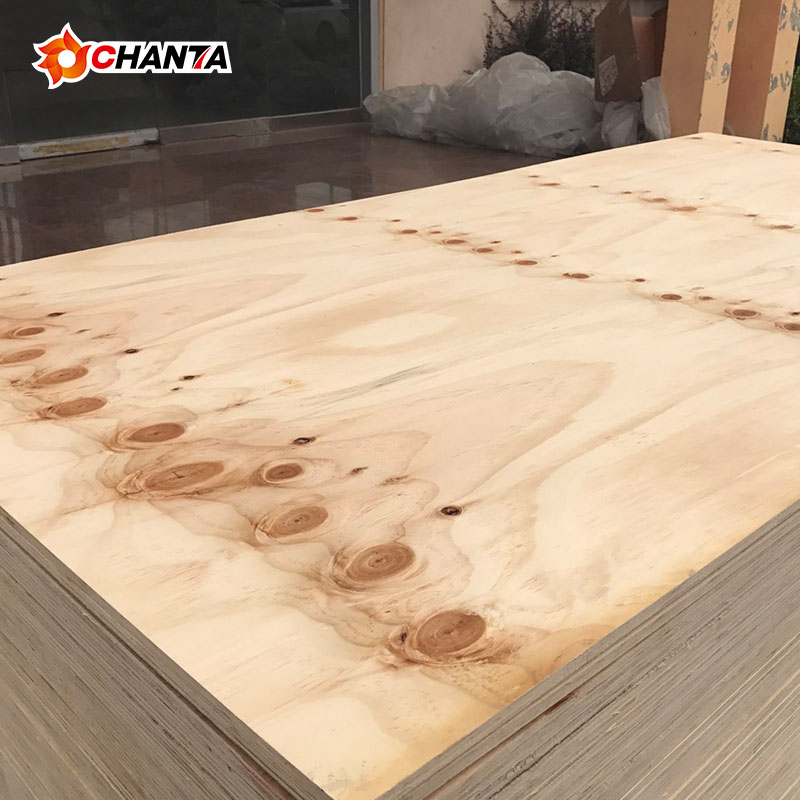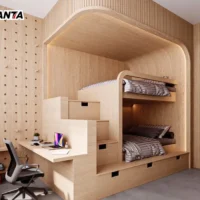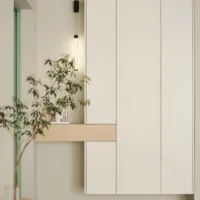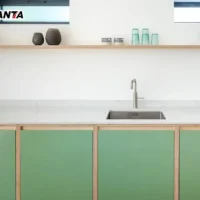Melamine plywood, MDF (Medium-Density Fiberboard), chipboard (particleboard), and OSB (Oriented Strand Board) are all popular choices in construction and furniture making. Each of these materials has its own set of characteristics that make it suitable for different applications. In this article, we will compare melamine plywood to these alternatives, highlighting its unique advantages and some limitations.
1. Melamine Plywood: Durability and Surface Protection
Melamine plywood consists of plywood that is covered with a melamine resin layer. This layer makes the surface scratch-resistant, durable, and easy to clean. Unlike natural wood, It does not require additional finishing, which saves both time and cost. Its tough surface can resist damage from heat, moisture, and chemicals, making it ideal for use in kitchen cabinets, furniture, and high-traffic areas.
Advantages of Melamine Plywood:
- Scratch and heat resistance: The melamine coating offers protection against wear, scratches, and heat, making it long-lasting.
- Ease of cleaning: The smooth, non-porous surface is easy to clean and maintain, unlike natural wood or unfinished plywood.
- Variety in design: Available in many colors and patterns, It offers design flexibility for various aesthetics.
Limitations:
- Vulnerability to moisture at edges: If the edges are not sealed properly, water can penetrate and cause the wood layers to swell.
- Weight: It tends to be heavier than MDF and chipboard, which can limit its use in some applications where weight is a concern.
- edge band:All furniture boards need to use edge sealing strips to seal edges, increase product life and look beautiful.
2. MDF (Medium-Density Fiberboard): Smooth Surface but Prone to Moisture
MDF is made from fine wood fibers and resin, compressed under heat and pressure. It provides a very smooth and uniform surface, making it ideal for painting or laminating. MDF is often used in interior applications, such as shelving and cabinetry. However, it is not as moisture-resistant as melamine plywood and can swell when exposed to water.
Advantages of MDF:
- Smooth finish: Its fine texture allows for an excellent paint finish or veneer application.
- Affordability: MDF is generally cheaper than melamine plywood.
- Easy to cut: MDF is easy to shape and cut for customized projects.
Limitations:
- Moisture sensitivity: MDF can absorb water quickly, causing it to swell or deform.
- Weaker strength: Compared to melamine plywood, MDF is not as strong and durable, particularly for heavy-duty applications.
3. Chipboard (Particleboard): Economical but Less Durable
Chipboard is made from wood chips and sawdust bonded together with resin. It is the most affordable option, commonly used in low-cost furniture and shelving. While chipboard is lighter and cheaper than melamine plywood, it lacks durability and strength. Without a surface finish, it is also more prone to damage from water and scratches.
Advantages of Chipboard:
- Cost-effective: Chipboard is an economical choice for temporary or budget-conscious projects.
- Lightweight: It is lighter than both melamine plywood and MDF, making it easier to handle.
Limitations:
- Low durability: Chipboard can chip and break easily, especially around the edges.
- Poor water resistance: It is highly prone to swelling and damage when exposed to moisture.
4. OSB (Oriented Strand Board): Strong but Rough Surface
OSB is made from large wood strands that are arranged in layers and bonded with adhesives. It is stronger than chipboard and even MDF, making it suitable for structural applications like wall sheathing and roofing. However, OSB’s surface is rough, making it less ideal for visible furniture or interior use without additional finishing.
Advantages of OSB:
- Structural strength: OSB is often used in construction due to its high strength and durability.
- Affordability: It offers a cost-effective alternative to plywood for load-bearing uses.
Limitations:
- Rough surface: OSB’s surface requires additional finishing for aesthetic uses.
- Not as moisture-resistant as plywood: Though more water-resistant than MDF, OSB can still be affected by prolonged moisture exposure.
5. Unique Advantages of Melamine Plywood Over Competitors
When comparing melamine plywood to MDF, chipboard, and OSB, its surface durability and design flexibility stand out. Unlike MDF, melamine plywood is far more resistant to moisture, making it a better choice for humid environments like kitchens or bathrooms. Its strength and aesthetic options also surpass chipboard, offering better long-term performance. While OSB may excel in structural uses, melamine plywood is the preferred choice where a combination of durability, appearance, and ease of maintenance is required.
Conclusion: Choosing the Right Material
Each material—melamine plywood, MDF, chipboard, and OSB—has specific uses where it excels. Melamine plywood offers a superior combination of strength, durability, and design, making it ideal for furniture, cabinetry, and interior decoration. Its resistance to heat, scratches, and moisture gives it an edge over MDF and chipboard, while its smoother finish makes it more suitable for visible applications than OSB. Depending on your needs, whether it’s structural support, aesthetic appeal, or cost-effectiveness, the right choice will vary, but melamine plywood often emerges as the top contender for versatile, long-lasting use.




















